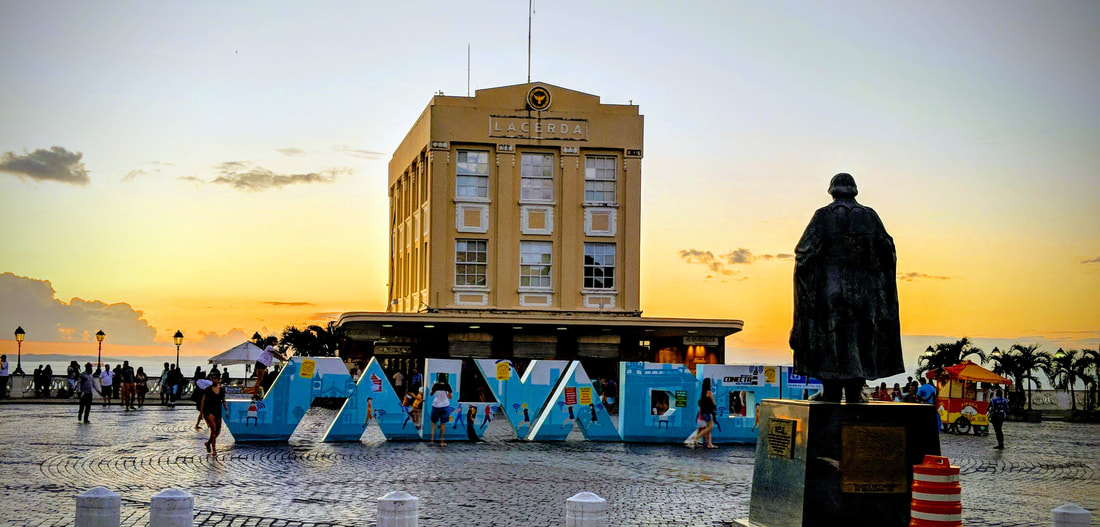|
By Ellie Nielsen and Morgan Ebel Our time in Brazil has only just begun, but already we see the influence schools have on this society. We had a lecture with Cloves Oliveria, a professor from the Federal University of Bahia, who laid out a broad description of Brazil’s education system – primary, secondary, and higher education. We also visited Instituto Cultural Steve Biko and learned the differences of what public versus private schools mean in this country, how their entrance exam works, and how it is structurally racist. In this short recap and reflection, we will cover the history of Brazil’s education system, the current state of their education system and finally what the relationship between race and the education system looks like. History of the Education System Brazil has a complicated history when it comes to their education system being that they were colonized by the Portuguese, a western European nation. During the colonial era, which was between the years 1500 and 1822, Portuguese and western culture hosted great power over education in Brazil. Especially in the sense of the Catholic church (McNally 2019). The Jesuit missionaries played an important role in shaping Brazilian society and their schools. They aimed to increase the Portuguese language literacy among Indigenous populations in addition to converting the native population to Catholicism. Enslaved Black people were discriminated against to a greater extent as they were completely excluded from obtaining any form of education (McNally 2019). This power and influence Catholicism has had throughout Brazilian History further connects to the fact that the nation currently has the largest population of Catholic Christians in the world with 61 percent of the total population believing in the faith (McNally 2019). After the Colonial period and when Brazil became an independent nation in 1822, only 10 percent of the school-aged children were enrolled in elementary school (McNally 2019). It was at this time that the nation began initiating an increased control over their primary education system. By 1934, Brazil’s government advanced their constitution and made education a basic right for all Brazilian citizens. Then in 1961, they adopted the first official national education law stating that elementary education would be compulsory until grade eight (McNally 2019). Although this had a significant impact on Brazilian society, the military dictatorship was still in power and proved the continuation of their elitist society by expanding higher education and not putting any focus into developing primary education (Kang 2018, 769). Both Brazil’s government and society has slowly placed more importance and focus on their education throughout their history – despite the governmental situation Brazil has been in the last four years. Current State of the Education System Currently, the nation of Brazil is considered a federation made up of 26 states with the self-governing federal district and capital of Brasilia. While the military controlled the government, from the years 1964 to 1985, Brazil experienced an extreme centralized government. But since then, Brazil has continuously worked to decentralize their political system and now possesses a formal decentralized country with strong state governments (McNally 2019). The national government decides education policies for the nation and is responsible for higher education. However, primary, or basic education is administered by state and municipal government entities and proves to have much autonomy within the federal guidelines (McNally 2019). This allows for schools and teachers to adapt their coursework to specific student needs. Furthermore, the main federal authority for Brazil’s education system is called the National Education Council, an agency of the Ministry of Education. The basic education is comprised of three stages – early childhood education (ages 4-5), elementary education (grades 1-9), and secondary education (grades 10-12). Basic education in Brazil is free at public schools and compulsory which has recently been extended to both early childhood and secondary schooling (McNally 2019). Another added legality is that Brazilian children must now attend two years of early childhood education as well as attend school until the age of 17 – the previous age was 14 (McNally 2019). Additionally, the national curriculum requirement contains mandated courses, but the state and local levels can implement content relevant to society and cultures. The required curriculum includes Portuguese, mathematics, history, geography, arts, natural sciences, physical education and since 2016, English beginning in grade six (McNally 2019). Once students' complete grade nine, they are given a certificate of completion and officially graduate elementary school. School enrollment and dropout rates have been an ongoing challenge for Brazilian educations and officials. In 2018, 99 percent of eligible first year students across the nation entered first grade. Although dropout rates remained at zero for developed and wealthy states like Santa Catarina, Mato Grosso, and Pernambuco, they increased in states that are considered developing and poorer. Developing states in the north and northeastern parts of the country in particular struggled with high rates of dropout. In the states of Sergipe and Bahia the dropout rates hovered around 76 percent in 2014 and 2015 (McNally 2019). Putting this issue into perspective further, the average years of schooling in Brazilian adults is approximately 7.8 years (Barro 2018, 769). Even though advancements have been made to expand the access of primary education and the youth literacy rate has continued to increase, dropout rates remain high in numerous parts of the nation. Race Relations in the Education System Brazil's high school education system is split in to three categories: private school, military school, and public school. Private high schools can be very expensive which is why most students come from wealthier, white families. Private high schools hold better education and have access to many more resources compared to public schools. Public schools, on the other hand, are free for students. Military schools fall somewhat in between the two. However, when it comes to university, these roles are switched, and public schools are much more prestigious than private schools. It is very difficult for students to be accepted to public university, and it is especially difficult for students coming from public high schools. The main priority in all high schools is to focus on studying for the university entrance exams. This exam is similar to the ACT or SAT that we use in the United States, but the stakes are much higher as this is the only thing students can do to be accepted to any university. Because of this, private high schools focus almost all of their three years on studying for this exam. They are taught how to take an exam, as long as any information may be presented. Public high schools however, do not have the resources to prepare their students at the same level. This creates a large divide between exam scores of private and public high school students (Instituto Cultural 2022). The problem with this system is that many of the students who attend public high schools and struggle more on the university exam are black and brown people. Public universities are largely made up of white students as they also make up most of private high schools. For this reason, schools created a quota system through Affirmative Action. This is a system in which a certain amount of seats are reserved for incoming students which are based on race, income, and whether they went to private or public high school. Each state has a 50% quota that is adjusted on each states census, 50% will go to public school students, and 50% are open. This is a federal law, but not all schools have to follow. For example, Bahia has the largest number of black people in the country and leaves 40% out of the 50% quota for black and brown students (Instituto Cultural 2022). In order to be eligible for the quota, the student must take the entrance exam. Conclusion We can see that Brazil as a whole has had many issues with race in the past, and many of them still continue. We look specifically at Brazils education system as we uncover both historic and present facts that prove the system to be racist. Even after the abolishment of slavery, racism and discrimination still heavily continued. Racism has left a lasting imprint on Brazils education systems and students of color are still patronized. School dropout rates are extremely high today in low income areas and students of color are at a very large disadvantage compared to those that are white and/or wealthy. In closing, we have found that the relationship between race and Brazil’s education system is a challenging concept to completely understand as it is evolving, but we are eager to continue learning. Bibliography Barro, Robert J. and Jong-Wha Lee “ A New Data Set of Educational Attainment in the World” Journal of Development Economics 104 (2013): 184-198. “Instituto Cultural Steve Biko.” Instituto Cultural Steve Biko. Class lecture at Instituto Cultural Steve Biko, Salvador, Brazil, May 20, 2022. Kang, Thomas H. “Education and Development Projects in Brazil, 1932-2004: A Critique.” Brazilian Journal of Political Economy 38, no. 4 (October 2018): 766-80. McNally, Ryan, Carlos Monroy, and Stefan Trines. “Education in Brazil.” World Education News and Reviews published November 14, 2019 https://wenr.wes.org/2019/11/education-in-brazil.  Morgan Ebel is a sophomore at the College of St. Benedict and the University of St. John’s University. She is originally from Farmington, Minnesota (no, she does not live on a farm). Morgan enjoys reading, working out (yoga, lifting, basketball, etc.) and spending time with her puppy named Teddy. Morgan is pursuing a degree in political science and a minor in sociology. Hopefully attaining a law degree in the near future.  Ellie Nielsen is a rising junior at CSBSJU. She is a psychology major with a focus in criminal psychology, as well as a political science minor. She and her family are from Farmington, Minnesota. She likes to read, spend time outside, and be surrounded by friends and family.
0 Comments
Leave a Reply. |
Archives
June 2024
Categories
All
|


 RSS Feed
RSS Feed
